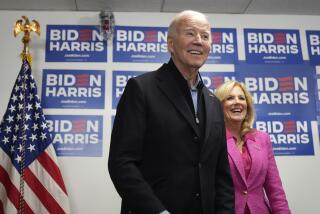Accent Is on German in South Carolina ‘Boom Belt’ : Development: Once-sleepy region is beacon for foreign investment. But some fear loss of small-town feel.
- Share via
SPARTANBURG, S.C. — When Paul Foerster moved to Spartanburg in 1967 as an executive with a German chemical-products firm, his new home, he says, “met all of the specifications of a sleepy little Southern mill town.”
There were few other foreign firms (or foreign-born residents, for that matter), and the ones that were here all were in some way related to textiles, far and away the dominant industry.
As seen when driving on the interstate today, past a clutch of fast-food joints and chain motels, this unpretentious city of 44,000 still looks like a sleepy Southern town. But Spartanburg is now one of the twin capitals of a growing metropolitan area that boasts the highest concentration of direct foreign investment in the nation, much of it German.
The influx of dollars and new influences into the Greenville-Spartanburg area has wrought astounding social and economic change. “In many ways, Spartanburg and Greenville today may be more sophisticated than Atlanta,” said Walter B. Edgar, director of the University of South Carolina Institute of Southern Studies.
This is a gross overstatement, as Edgar readily admits a moment later. But for their size, the cities are surprisingly cosmopolitan--a byproduct of the infusion of foreign investment and newcomers.
In the last five years, the area has seen $4.2 billion in capital investment, much of it coming from such firms as Hitachi, Michelin and now BMW, which, with much fanfare and fireworks, officially opened its first plant outside of Germany here last week.
The transformation from sleepy backwater to international business beacon has not been without conflict. The town of Greer, on BMW’s doorstep, is one of the poorest in the state. But even so, many of its residents were not happy with the coming of BMW, fearing that the presence of the corporate giant would destroy its small-town flavor.
“There was in some sectors a lot of resentment that the way of life is going to change so drastically over the next few years,” said Don Wall, the mayor of Greer. “But I think most people realize now that change is inevitable.”
One sign of change is that Foerster, a German citizen, this year was elected chairman of the Spartanburg Area Chamber of Commerce.
Another is the increasing presence of European delis and Japanese restaurants sprinkled throughout the two larger cities, and the new prominence of foreign languages--including German--in school and college curricula. The number of foreign-born residents is not large--the new companies only import their top managers--but BMW spokesman and South Carolinian Robert Hitt said nobody takes notice anymore when they hear someone speaking German in the supermarket.
The most obvious signs of change are in service-industry oriented Greenville (population 60,000), where the downtown boasts modern office buildings, a Hyatt Regency Hotel and a smattering of exotic restaurants, galleries and shops. The Chamber of Commerce claims the county has more engineers than any other county in the nation.
You know you’ve left grits-and-poke-sallet territory when you hit Greenville, perhaps the only South Carolina city outside of touristy Charleston--and probably the only city of its size anywhere in the South--where you’ll find restaurants serving such dishes as sesame-encrusted salmon served on a bed of field greens with shiitake mushroom fingers and topped with a wasabi vinaigrette. The dish was on the menu at the restaurant where BMW hosted a party for international journalists in conjunction with its plant opening.
If the journalists came expecting to find an accent on regional quaintness, they left disappointed. Aside from the frequent references to Southern hospitality and the ubiquitous Carolina drawls, the opening ceremony could have taken place anywhere.
In ceremonies that were televised live throughout the region, the Greenville Symphony Orchestra performed pieces by Aaron Copland, Leonard Bernstein and George Gershwin. Afterward at a reception, the 2,000 invited guests dined on lobster medallions, smoked sturgeon and roast rack of lamb Provencal.
“This is South Carolina at its best,” one sated state official said.
*
It was the 1992 decision by Bavarian Motor Works to build its $400-million plant here that first signaled, as Gov. Carroll A. Campbell Jr. said recently, that “little South Carolina is a big league player in the global economy.” Before the first car rolled off the production line, the company’s total projected investment had reached $800 million.
Business Week magazine, in a cover story, christened the 377-mile stretch of Interstate 85 between Atlanta and Raleigh-Durham, N.C., America’s new boom belt.
But the corridor--and especially the Greenville-Spartanburg area--has been attracting international business for more than three decades. Beginning in the late 1950s, while the rest of the Deep South was mired in racial controversies, South Carolina began to aggressively recruit industrial development, first from Northern states, then overseas. The area is reaping the benefits of its foresight.
With 215 international firms, South Carolina ranks 13th among U.S. states in foreign investment. BMW is the 76th German firm to invest in the state. Most of the German money has gone to what is called the upstate region around Greenville and Spartanburg. There also is significant investment in the region from Japan, Britain and France.
One large factor in the area’s favor is its location halfway between the booming cities of Atlanta and Charlotte, N.C. It also has the state’s largest airport and is dissected by two interstates and two major railroads, allowing easy market access.
The significance of the BMW plant goes far beyond the 2,000 jobs it eventually will provide and the $1 billion it is expected to pump into the area’s economy. The company’s prestige and reputation for quality craftsmanship will be a major boon for a state that has long ranked near the bottom in national high school graduation levels.
“The typical European view of education in the United States is that it’s no good and that it is especially not good in the Southeast in general,” Foerster said. But South Carolina has made recent improvements in its education system--as have a number of other Southern states--and schools in Greenville and Spartanburg are considered by many to be among the best in the state.
The biggest benefit of BMW coming here is that other companies might say, as Campbell predicted: “If it’s good enough for BMW, maybe it’s good enough for us.”
Perhaps the biggest factor in the area’s success in attracting foreign investors has been the state’s training program for new workers. Since 1961, South Carolina has provided free, specialized training for workers when a major industry decides to build a plant or substantially expand. For BMW, in addition to the $130 million in other incentives, the state even screened job applicants--more than 60,000 people for the 570 initial jobs.
Another factor is the state’s relatively calm racial climate. The Confederate flag that still flies over the Statehouse has sparked demonstrations, and the state Supreme Court heard arguments on whether it should come down on the same day that BMW held its opening ceremonies. But South Carolina has been largely free of the bloody clashes and high tensions that long made Mississippi, Alabama and southern Georgia undesirable areas for relocating businesses, Edgar said.
Public facilities and colleges were desegregated relatively smoothly in South Carolina in 1963, Edgar said in his book “South Carolina in the Modern Age.”
Speaking of South Carolina political and business leaders in the 1960s and 1970s, Edgar said: “They didn’t say: ‘We are selling social stability,’ but that’s what they were selling.”
*
To get a glimpse of what the upstate area was like before three decades of foreign investment and the influx of newcomers, one needs not venture far. Until recently, the town of Greer--which straddles the Spartanburg County and Greenville County border--did not try to partake of the region’s growth.
For decades Greer was a company town, dominated by the three textile mills that furnished modest cookie-cutter housing for its workers in four mill villages, each with company-owned stores. Residents were dependent on the companies for just about everything. With the decline of the domestic textile industry in the 1950s and 1960s, the town went into decline.
The central business district became dreary, almost nonexistent.
“Greer had reached the point of diminishing returns,” said City Administrator Ken Westmoreland. “It was about at the point of collapse. (The city’s neighborhoods) would’ve become ghettos in the not too distant future.”
Things started to improve about three years ago--one year before BMW decided to relocate next door--when newly elected city leaders decided to take advantage of its location and started aggressively wooing development.
Given the new pro-business attitude of town officials, you’d think there would have been dancing in the streets when BMW announced it would build here. Instead, Greer officials and BMW have been at odds from the beginning.
First, Greer had planned to increase its tax base by annexing the proposed BMW site. When the governor surprised everyone by presenting BMW as a done deal, Greer asked the company if it would voluntarily allow annexation. The city offered police and fire protection in return for $2 million a year in taxes. The money, Wall said, would have helped the city cope with the increased growth BMW’s coming would cause.
When the company refused, Greer annexed it anyway. The state Supreme Court blocked the move. The state then stepped in to build a road that would open up a new industrial development corridor while at the same time diverting traffic from the city.
Another sore point for Greer officials is that BMW calls the factory its Spartanburg plant when it actually abuts Greer. In the town’s view, Greer is experiencing the impact of the plant but getting no direct financial benefits and none of the glory.
City officials say they thought they’d be able to lure some of BMW’s suppliers to Greer, but so far the suppliers have elected to build elsewhere. In fact, some suppliers are locating as far away as Georgia in hopes of doing business with both BMW and Mercedes, which is building a factory in Alabama.
The latest controversy is over the name of a city road that runs past the plant. The company wants it renamed “BMW Parkway.” The city, still smarting over what it considers shabby treatment, refused.
The relationship is improving--the city and the company are cooperating on a few projects--and Westmoreland predicts that the road may be renamed when tempers cool off.
Officials are confidant the town’s future is assured, with or without BMW. Greer has seen nearly $30 million in capital investment in the last three years, including 12 new residential subdivisions with a planned 3,000 houses ranging in price between $65,000 to $200,000. Because of the new housing and an aggressive annexation program, city officials say the population has increased 40% since 1990, to 14,000.
Touring his town, proudly showing off development projects and making ambitious predictions about its growth, Westmoreland said: “I think Greer, in fact, will have a fighting chance for the future.”
And he added: “BMW is really just immaterial.”
More to Read
Inside the business of entertainment
The Wide Shot brings you news, analysis and insights on everything from streaming wars to production — and what it all means for the future.
You may occasionally receive promotional content from the Los Angeles Times.










